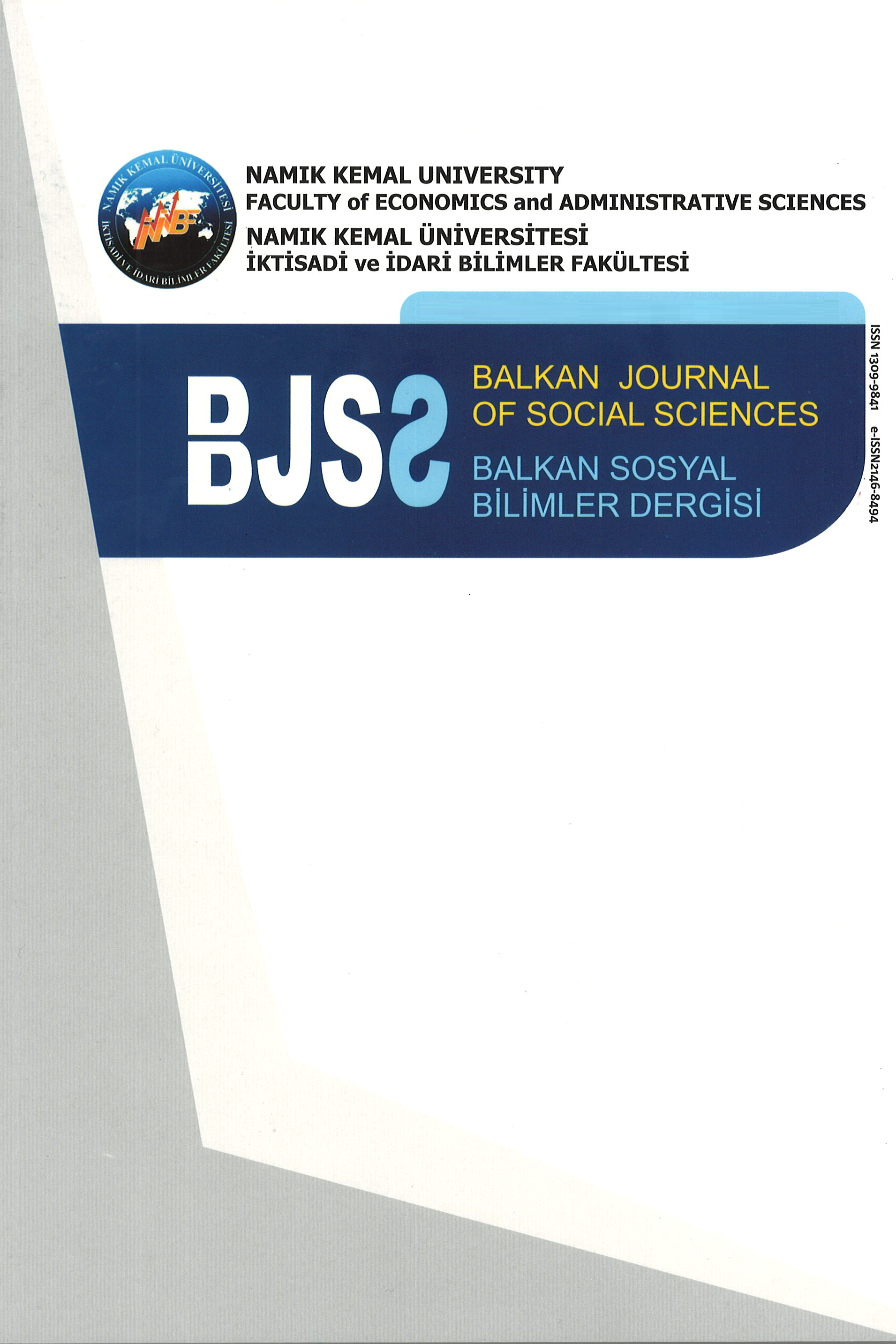Savunma Harcamaları ve Ekonomik Büyüme İlişkisi: Türkiye Örneği
İkinci Dünya Savaşı sonrasında özellikle Soğuk Savaş dönemi ile birlikte savunma harcamalarında dünya genelinde artış görülmüş ve savunma harcamaları 1980’lerin sonunda en üst seviyelere yükselmiştir. Sonraki dönemde artan terör saldırıları ile ülkeler milli güvenlik politikalarının revize etmişlerdir. Türkiye savaşların yoğun bir şekilde yaşandığı Ortadoğu’da yer almakta ve bu nedenle güçlü bir ordunun varlığı Türkiye için hayati bir önem sahiptir. Gerek uzun yıllardır süren terör olayları gerekse bölgede önemli bir güç olması nedeniyle savunma harcamalarının Türkiye ekonomisi içerisindeki payı oldukça fazladır. Çalışmada savunma harcamaları ile ekonomik büyüme arasındaki ilişki 1968-2017 dönemi Türkiye özelinde yıllık veriler kullanılarak incelenmektedir. Analizde ilgili değişkenler arasındaki kısa ve uzun dönemli nedensellik ilişkisi Breitung ve Candelon (2006) tarafından geliştirilen frekans alanında nedensellik testi kullanılarak incelenmiştir. Analiz sonucunda Türkiye ekonomisinde savunma harcamalarından ekonomik büyümeye yönelik tek yönlü bir nedensellik ilişkisi tespit edilmiştir. Etki-tepki analizi sonuçları savunma harcamalarındaki beklenmedik bir artışa GSYİH’nin vermiş olduğu tepkinin uzun dönemde negatif ve istatistiksel olarak anlamlı olduğunu göstermektedir.
Anahtar Kelimeler:
Savunma Harcamaları, Ekonomik büyüme, Nedensellik
The Relation between Military Expenditure and Economic Growth: Evidence from Turkey
After the Second World War, especially in the Cold War era, military expenditures increased worldwide and it has reached its highest levels in the late 1980s. The countries have revised their national security policies due to the increasing terrorist attacks in the following period. Turkey is located in the Middle East is experiencing an intense battle and hence the existence of a strong army has a vital importance for Turkey. The share of military spending in Turkey’s economy is very high because of long-standing terrorist incidents and being an important force in the region. The relationship between economic growth and defense spending is analyzed by using annual data for the 1968-2017 periods in Turkey. The short- and long-term causality relationships between related variables are examined by means of using the frequency domain causality test suggested by Breitung and Candelon (2006). We find evidence in favor of the causal link running from military expenditures to economic growth. The impulse-responses analysis results suggest that the responses of the GDP to an unexpected military spending are negative and statistically significant in the long-term.
Keywords:
Military Expenditures, Economic Growth, Causality,
___
- Ball, N. (1983). Defense and development: A critique of benoit study. Economic Development and Cultural Change, 31(3), 507-524.
- Bektaş, G. (2017). Savunma harcamalarının ekonomik büyümeye etkisi: Türkiye örneği. Yüksek Lisans Tezi, Tekirdağ: Tekirdağ Namık Kemal Üniversitesi.
- Breitung, J., & Candelon, B. (2006). Testing for short- and long-run causality: A frequency-domain approach. Journal of Econometrics, 132(2), 363-378.
- Chan, S. (1987). Military expenditures and economic performance in World Military Expenditures and Arms Transfer. Washington, D.C.: U.S. Arms Control and Disarmament Agency.
- Chowdhury, A. R. (1991). A casual analysis of defense spending and economic growth. The Journal of Conflict Resolution, 35(1), 80-97.
- Davis, D. R., & Chan, S. (1990). The security welfare relationship: Longitudinal evidence from Taiwan. Journal of Peace Research, 27(1), 87-100.
- Değer, S. (1986). Economic development and defense expenditure. Economic Development and Cultural Change, 35(1), 179-196.
- Dunne, J. P, & Üye, M. (2009). Military spending and development. Working Papers, No: 0902, Department of Accounting, Economics and Finance, Bristol Business School, University of the West of England, Bristol.
- Dunne, J. P., & Nikolaidou, E. (2005). Military spending and economic growth in Greece, Portugal and Spain. Frontiers in Finance and Economics, 2(1), 1-17
- Geweke, J. (1982). Measurement of linear dependence and feedback between multiple time series. Journal of the American Statistical Association, 77, 304-324.
- Hatemi-J, A., Chang, T., Chen, W-Y., Lin, F-L., & Gupta, R. (2018). Asymmetric causality between military expenditures and economic growth in top six defense spenders. Quality & Quantity: International Journal of Methodology, 52(3), 1193-1207.
- Hosoya, Y. (2001). Elimination of third-series effect and defining partial measures of causality. Journal of Time Series Analysis, 22: 537-554.
- Huang, C., & Mintz, A. (1990). Ridge regression analysis of the defence-growth tradeoff in the United States. Defence Economics, 2 (1), 29-37.
- Islam, M. O. (2015). The relation between military expenditure and economic growth in developing countries: Evidence from a panel of 41 developing countries. IOSR Journal of Economics and Finance, 6(4), 57-65.
- Kalyoncu, H., & Yücel, F. (2006). An analytical approach on defense expenditure and economic growth: The case of Turkey and Greece. Journal of Economic Studies, 33(5), 336-343.
- Koban, E. (1998). Savunma harcamalari, ekonomik etkileri ve Türkiye’deki gelişimi. Genelkurmay Askeri Tarih ve Stratejik Etüt Başkanlığı, Ankara; Sayı: 355.
- Kollias, C. (1997). Defence spending and growth in Turkey 1954-1993: A causal analysis. Defence and Peace Economics, 8(2), 189-204.
- Kollias, C., Manolas, G., & Paleologou, S. M. (2004). Defence expenditure and economic growth in the European Union: A causality analysis. Journal of Policy Modeling, 26(5), 553-569.
- Looney, R. E. (1988). Third world military expenditure and arms production. London: Macmillan, 1988.
- Sezgin, S. (1997). Country survey X: Defence spending in Turkey. Defence and Peace Economics, 8(4), 381-409.
- Sezgin, S. (2001). An empirical analysis of turkey’s defence-growth relationships with a multi-equation model (1956-1994). Defence and Peace Economics, 12(1), 69-86.
- SIPRI [Stockholm International Peace Research Institute] (2019). SIPRI Military Expenditure Database. (Erişim: 01.03.2019), https://www.sipri.org/databases/milex
- Yakovlev, P. (2007). Arms trade, military spending, and economic growth. Defence and Peace Economics, 18(4), 317-338.
- Yılancı, V., & Özcan, B. (2010). Yapısal kırılmalar altında Türkiye için savunma harcamaları ile GSMH arasındaki ilişkinin analizi. Cumhuriyet Üniversitesi İktisadi ve İdari Bilimler Dergisi, 11(1), 21-33.
- Yayın Aralığı: Yılda 2 Sayı
- Başlangıç: 2011
- Yayıncı: Tekirdağ Namık Kemal Üniversitesi
